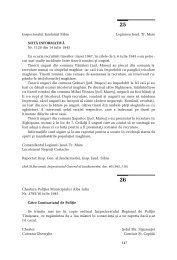Southeast Europe
Southeast Europe
Southeast Europe
You also want an ePaper? Increase the reach of your titles
YUMPU automatically turns print PDFs into web optimized ePapers that Google loves.
decide to continue their studies in Hungary. The Hungarian government annually<br />
sponsors a number of students for doctoral programmes in Hungary. Few of them return<br />
to their home country.<br />
7. COMMUNICATION AND AUDIOVISUAL MEDIA<br />
7.1 Legal situation<br />
The National Audio-Visual Council oversees the media in Romania. A body comprised<br />
of eleven members came into being with the Audio-Visual Law on May 19, 1992. The<br />
government was criticised at the time because all eleven members of the council were<br />
ethnic Romanians. Complaints were justified as minorities comprise approximately 10%<br />
of the total population of the country, and they should be entitled to have a<br />
representative on the Audio-Visual Council (Helsinki Watch, 1993:51).<br />
Later, an ethnic Hungarian became a member of the National Audio-Visual Council.<br />
This Council plays an important role in issuing licenses to TV or radio stations, some of<br />
them broadcasting in the language of the ethnic minorities. Another important aspect<br />
concerned the regulations of the electoral campaign on radio and TV. In September<br />
2000, the regulations were changed to improve ethnic minorities’ access to this type of<br />
media, and other changes on language usage and the use of different symbols (Balló,<br />
2000).<br />
7.2 Press<br />
There is no specific legislation concerning the press. There were discussions in<br />
parliament about the necessity of a press law, “but the majority of the journalists and<br />
others said that an adequate civil code should be a proper legal framework for a wellfunctioning<br />
written media” (Balló, 2000).<br />
There are currently a large number of Hungarian-language publications (see addresses),<br />
many on a daily or weekly basis. Most of these are privately run and financed<br />
(Government of Romania, Council for National Minorities, 1994:85). It should be<br />
mentioned that there are two national and seven regional or local daily Hungarian<br />
newspapers in Romania (Balló, 2000).<br />
The importance of the Hungarian-language media depends on the part of the country to<br />
which one it refers. For instance in Cluj, a city with approximately 20% Hungarian<br />
population has a vehemently anti-Hungarian mayor, Gheorghe Funar. The Hungarianlanguage<br />
newspaper in Cluj, Szabadság, is therefore vital to the Hungarian population<br />
of the city, providing them with a voice through which they can express themselves<br />
with regard to all of the current important issues in the region. In contrast, Heti Új Szó<br />
in Timişoara has a far smaller readership. The Heti Új Szó used to be a daily, but it had<br />
to turn into a weekly because of the unfavourable economic conditions in the first half<br />
of the 1990s.<br />
Balló Áron, editor-in-chief of Szabadság, has another opinion about the success factors<br />
of a Hungarian newspaper. Not only the existing interethnic situation or the “need to<br />
find a voice” of the Hungarian population in an intolerant climate motivates the<br />
population to buy the newspaper. The Oradea or Satu Mare Hungarian-language daily<br />
newspapers like the Bihari Napló and the Szatmári Friss Újság. They serve a Hungarian<br />
population of a similar size to the one served by the Szabadság in Cluj, and there is<br />
probably less interethnic tension in Oradea or Satu Mare than in Cluj. Even so, the<br />
51









